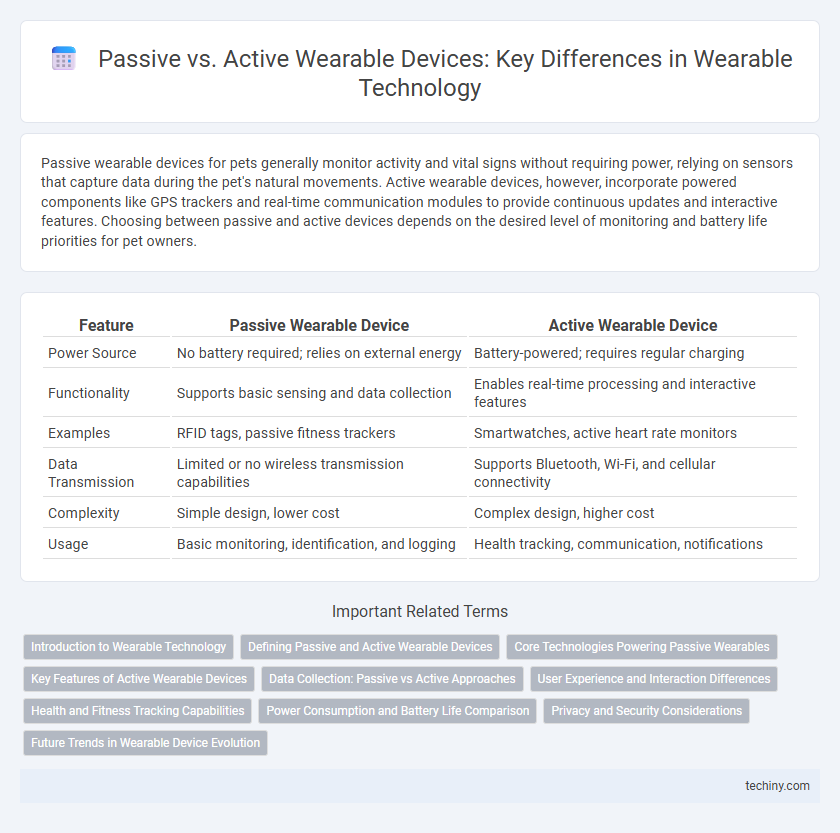Passive wearable devices for pets generally monitor activity and vital signs without requiring power, relying on sensors that capture data during the pet's natural movements. Active wearable devices, however, incorporate powered components like GPS trackers and real-time communication modules to provide continuous updates and interactive features. Choosing between passive and active devices depends on the desired level of monitoring and battery life priorities for pet owners.
Table of Comparison
| Feature | Passive Wearable Device | Active Wearable Device |
|---|---|---|
| Power Source | No battery required; relies on external energy | Battery-powered; requires regular charging |
| Functionality | Supports basic sensing and data collection | Enables real-time processing and interactive features |
| Examples | RFID tags, passive fitness trackers | Smartwatches, active heart rate monitors |
| Data Transmission | Limited or no wireless transmission capabilities | Supports Bluetooth, Wi-Fi, and cellular connectivity |
| Complexity | Simple design, lower cost | Complex design, higher cost |
| Usage | Basic monitoring, identification, and logging | Health tracking, communication, notifications |
Introduction to Wearable Technology
Wearable technology includes both passive and active devices, where passive wearable devices primarily gather data without interacting with the environment, such as fitness trackers monitoring heart rate and sleep patterns. Active wearable devices, like smartwatches and augmented reality glasses, perform continuous processing and provide real-time feedback or interaction based on sensor data. Understanding the distinction between passive and active wearables is essential for optimizing user experience and energy efficiency in health monitoring and smart applications.
Defining Passive and Active Wearable Devices
Passive wearable devices collect and monitor data without requiring user interaction or active power sources, often relying on ambient energy or sensors to track metrics like heart rate or movement. Active wearable devices, in contrast, use batteries or dedicated power to perform functions such as real-time data processing, alerts, and user input, enabling enhanced interactivity and advanced features. Understanding the distinction between passive and active wearables is crucial for selecting the appropriate technology based on energy consumption, functionality, and user engagement needs.
Core Technologies Powering Passive Wearables
Passive wearable devices rely on core technologies such as energy harvesting, flexible sensors, and low-power communication modules to operate without an internal power source. Energy harvesting methods include thermoelectric generators, piezoelectric materials, and RFID-based power transfer, enabling continuous functionality through ambient energy capture. These innovations differentiate passive wearables from active devices by minimizing battery dependence and enhancing user comfort and device longevity.
Key Features of Active Wearable Devices
Active wearable devices feature integrated sensors and processors that enable real-time data collection, analysis, and feedback, enhancing user interaction and health monitoring. These devices often include functionalities such as GPS tracking, heart rate monitoring, and wireless connectivity for seamless data synchronization with smartphones or cloud platforms. Their battery-powered operation supports continuous performance measurement and personalized alerts, distinguishing them from passive wearables which primarily collect data without processing capabilities.
Data Collection: Passive vs Active Approaches
Passive wearable devices collect data continuously through embedded sensors without user input, capturing metrics like heart rate, movement, and sleep patterns in real-time. Active wearable devices require user interaction to initiate data capture, often tracking specific activities or health metrics on demand. The passive approach ensures comprehensive, uninterrupted monitoring ideal for long-term trend analysis, while the active approach provides targeted, precise data suited for immediate feedback and user-driven insights.
User Experience and Interaction Differences
Passive wearable devices, such as fitness trackers, primarily monitor biometrics without requiring user input, offering a seamless and low-maintenance experience ideal for continuous health tracking. Active wearable devices, like smartwatches, enable direct user interaction through touchscreens and voice commands, providing real-time feedback and customizable functionalities that enhance engagement. The choice between passive and active wearables significantly impacts user experience, balancing convenience against interactivity and personalized control.
Health and Fitness Tracking Capabilities
Passive wearable devices primarily focus on monitoring health and fitness metrics through sensors that collect data without user intervention, such as heart rate, sleep patterns, and activity levels. Active wearable devices not only track these metrics but also offer interactive features like real-time feedback, coaching, and exercise guidance through integrated software and connectivity. Both types enhance health management, but active wearables provide a more dynamic and personalized fitness experience.
Power Consumption and Battery Life Comparison
Passive wearable devices consume significantly less power than active wearables because they rely on external signals or body energy, resulting in extended battery life that can last weeks or months. Active wearable devices use onboard sensors and processors, requiring continuous power, which limits battery life to hours or a few days. This fundamental difference in power consumption impacts usability, with passive wearables being ideal for long-term monitoring and active wearables suited for real-time data processing and advanced functionalities.
Privacy and Security Considerations
Passive wearable devices, such as fitness trackers that collect data without direct user interaction, raise concerns about continuous data monitoring and unauthorized access to sensitive health information. Active wearable devices, including smartwatches that process and transmit real-time data, demand robust encryption protocols and user authentication to prevent cyberattacks and data breaches. Prioritizing privacy safeguards and implementing end-to-end security measures are essential to protect user information across both passive and active wearable technologies.
Future Trends in Wearable Device Evolution
Future trends in wearable technology emphasize the integration of both passive and active wearable devices to enhance user health monitoring and environmental interaction. Passive wearable devices will advance through improved sensor accuracy and energy harvesting capabilities, enabling continuous, unobtrusive data collection without frequent charging. Active wearable devices are expected to evolve with smarter AI-driven functionalities, real-time feedback systems, and seamless connectivity to IoT networks, facilitating proactive health management and personalized user experiences.
Passive Wearable Device vs Active Wearable Device Infographic

 techiny.com
techiny.com